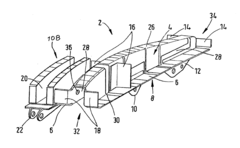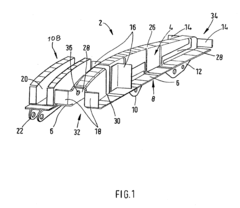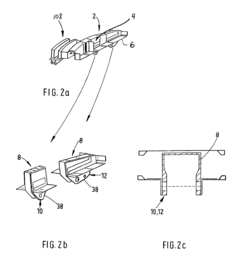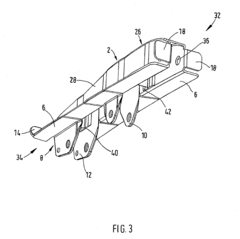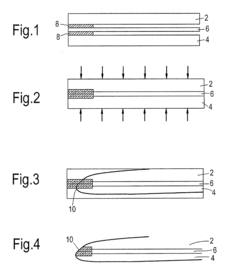How to Implement Ferrofluid in Aerospace Component Design?
JUL 9, 20259 MIN READ
Generate Your Research Report Instantly with AI Agent
Patsnap Eureka helps you evaluate technical feasibility & market potential.
Ferrofluid Aerospace Applications and Objectives
Ferrofluids, a unique class of magnetic nanomaterials, have garnered significant attention in the aerospace industry due to their potential to revolutionize component design and enhance overall system performance. These colloidal suspensions of magnetic nanoparticles in a carrier fluid exhibit remarkable properties that can be harnessed for various aerospace applications.
The primary objective of implementing ferrofluids in aerospace component design is to leverage their adaptive and responsive nature to address critical challenges in the field. One key goal is to improve the efficiency and reliability of various systems, such as propulsion, thermal management, and vibration control. By integrating ferrofluids into these systems, engineers aim to achieve better performance, reduced weight, and enhanced adaptability to varying operational conditions.
In the realm of propulsion, ferrofluids show promise in developing advanced sealing systems for rotating shafts in turbines and engines. The magnetic properties of ferrofluids allow for the creation of dynamic seals that can adapt to changes in pressure and temperature, potentially reducing friction and wear while improving overall efficiency. Additionally, researchers are exploring the use of ferrofluids in novel propulsion concepts, such as magnetohydrodynamic drives, which could offer new possibilities for spacecraft propulsion.
Thermal management is another critical area where ferrofluids can make a significant impact. The ability of ferrofluids to respond to magnetic fields can be exploited to create adaptive cooling systems that can efficiently dissipate heat from electronic components and other heat-generating elements in aerospace vehicles. This could lead to more compact and lightweight thermal management solutions, crucial for optimizing the performance of aircraft and spacecraft.
Vibration control is yet another promising application for ferrofluids in aerospace. By incorporating ferrofluid-based dampers into structural components, engineers aim to enhance the overall stability and reduce vibrations in aircraft and spacecraft. This could lead to improved comfort for passengers, extended lifespan of sensitive equipment, and increased structural integrity of aerospace vehicles.
The implementation of ferrofluids in aerospace component design also aligns with the broader industry trend towards smart materials and adaptive systems. By integrating ferrofluids into various components, aerospace engineers seek to create structures and systems that can dynamically respond to changing environmental conditions and operational requirements. This adaptability could significantly enhance the performance and versatility of aerospace vehicles across a wide range of missions and scenarios.
As research in this field progresses, the aerospace industry aims to develop standardized methods for incorporating ferrofluids into component design, ensuring reliability, safety, and scalability. The ultimate goal is to create a new generation of aerospace components that are more efficient, resilient, and capable of meeting the evolving demands of modern aviation and space exploration.
The primary objective of implementing ferrofluids in aerospace component design is to leverage their adaptive and responsive nature to address critical challenges in the field. One key goal is to improve the efficiency and reliability of various systems, such as propulsion, thermal management, and vibration control. By integrating ferrofluids into these systems, engineers aim to achieve better performance, reduced weight, and enhanced adaptability to varying operational conditions.
In the realm of propulsion, ferrofluids show promise in developing advanced sealing systems for rotating shafts in turbines and engines. The magnetic properties of ferrofluids allow for the creation of dynamic seals that can adapt to changes in pressure and temperature, potentially reducing friction and wear while improving overall efficiency. Additionally, researchers are exploring the use of ferrofluids in novel propulsion concepts, such as magnetohydrodynamic drives, which could offer new possibilities for spacecraft propulsion.
Thermal management is another critical area where ferrofluids can make a significant impact. The ability of ferrofluids to respond to magnetic fields can be exploited to create adaptive cooling systems that can efficiently dissipate heat from electronic components and other heat-generating elements in aerospace vehicles. This could lead to more compact and lightweight thermal management solutions, crucial for optimizing the performance of aircraft and spacecraft.
Vibration control is yet another promising application for ferrofluids in aerospace. By incorporating ferrofluid-based dampers into structural components, engineers aim to enhance the overall stability and reduce vibrations in aircraft and spacecraft. This could lead to improved comfort for passengers, extended lifespan of sensitive equipment, and increased structural integrity of aerospace vehicles.
The implementation of ferrofluids in aerospace component design also aligns with the broader industry trend towards smart materials and adaptive systems. By integrating ferrofluids into various components, aerospace engineers seek to create structures and systems that can dynamically respond to changing environmental conditions and operational requirements. This adaptability could significantly enhance the performance and versatility of aerospace vehicles across a wide range of missions and scenarios.
As research in this field progresses, the aerospace industry aims to develop standardized methods for incorporating ferrofluids into component design, ensuring reliability, safety, and scalability. The ultimate goal is to create a new generation of aerospace components that are more efficient, resilient, and capable of meeting the evolving demands of modern aviation and space exploration.
Aerospace Market Demand for Ferrofluid Technology
The aerospace industry has shown a growing interest in ferrofluid technology, driven by its unique properties and potential applications in various aerospace components. The market demand for ferrofluid-based solutions in aerospace is primarily fueled by the need for advanced thermal management systems, improved vibration damping, and enhanced sealing mechanisms in aircraft and spacecraft.
Thermal management is a critical aspect of aerospace design, and ferrofluids offer promising solutions. The ability of ferrofluids to respond to magnetic fields while maintaining liquid properties makes them ideal for developing adaptive cooling systems. These systems can efficiently dissipate heat in critical areas of aircraft engines, avionics, and other heat-generating components, potentially leading to improved performance and extended lifespan of aerospace equipment.
Vibration damping is another area where ferrofluids show significant potential. The aerospace industry constantly seeks ways to reduce vibrations in aircraft and spacecraft to enhance passenger comfort, protect sensitive equipment, and extend the operational life of components. Ferrofluid-based damping systems can provide adaptive and controllable damping, offering superior performance compared to traditional mechanical dampers.
Sealing mechanisms in aerospace applications often face extreme conditions, including high pressures, temperature variations, and exposure to harsh environments. Ferrofluids can be utilized to create dynamic seals that adapt to changing conditions, providing more effective sealing solutions for rotating shafts, bearings, and other moving parts in aerospace machinery.
The space sector, in particular, has shown keen interest in ferrofluid technology. In microgravity environments, ferrofluids can be used for fluid management systems, propulsion mechanisms, and even in life support systems. The ability to manipulate ferrofluids using magnetic fields offers unique advantages in the absence of gravity, opening up new possibilities for space exploration and satellite technology.
As the aerospace industry continues to push the boundaries of performance and efficiency, the demand for innovative materials and technologies like ferrofluids is expected to grow. Major aerospace manufacturers and research institutions are investing in ferrofluid research and development, recognizing its potential to address key challenges in the industry.
However, the adoption of ferrofluid technology in aerospace applications faces some challenges. These include the need for long-term stability of ferrofluids in aerospace environments, compatibility with existing materials and systems, and the development of reliable control mechanisms for ferrofluid-based components. Overcoming these challenges will be crucial for the widespread implementation of ferrofluid technology in aerospace design.
Thermal management is a critical aspect of aerospace design, and ferrofluids offer promising solutions. The ability of ferrofluids to respond to magnetic fields while maintaining liquid properties makes them ideal for developing adaptive cooling systems. These systems can efficiently dissipate heat in critical areas of aircraft engines, avionics, and other heat-generating components, potentially leading to improved performance and extended lifespan of aerospace equipment.
Vibration damping is another area where ferrofluids show significant potential. The aerospace industry constantly seeks ways to reduce vibrations in aircraft and spacecraft to enhance passenger comfort, protect sensitive equipment, and extend the operational life of components. Ferrofluid-based damping systems can provide adaptive and controllable damping, offering superior performance compared to traditional mechanical dampers.
Sealing mechanisms in aerospace applications often face extreme conditions, including high pressures, temperature variations, and exposure to harsh environments. Ferrofluids can be utilized to create dynamic seals that adapt to changing conditions, providing more effective sealing solutions for rotating shafts, bearings, and other moving parts in aerospace machinery.
The space sector, in particular, has shown keen interest in ferrofluid technology. In microgravity environments, ferrofluids can be used for fluid management systems, propulsion mechanisms, and even in life support systems. The ability to manipulate ferrofluids using magnetic fields offers unique advantages in the absence of gravity, opening up new possibilities for space exploration and satellite technology.
As the aerospace industry continues to push the boundaries of performance and efficiency, the demand for innovative materials and technologies like ferrofluids is expected to grow. Major aerospace manufacturers and research institutions are investing in ferrofluid research and development, recognizing its potential to address key challenges in the industry.
However, the adoption of ferrofluid technology in aerospace applications faces some challenges. These include the need for long-term stability of ferrofluids in aerospace environments, compatibility with existing materials and systems, and the development of reliable control mechanisms for ferrofluid-based components. Overcoming these challenges will be crucial for the widespread implementation of ferrofluid technology in aerospace design.
Current Challenges in Ferrofluid Aerospace Integration
The integration of ferrofluids into aerospace component design presents several significant challenges that researchers and engineers must overcome. One of the primary obstacles is the stability of ferrofluids in the extreme conditions encountered in aerospace applications. The harsh environment of space, including extreme temperature fluctuations, high radiation levels, and vacuum conditions, can potentially alter the properties of ferrofluids, affecting their performance and reliability.
Another critical challenge lies in the precise control and manipulation of ferrofluids within aerospace components. While ferrofluids offer unique advantages in terms of their responsiveness to magnetic fields, achieving precise and consistent control in microgravity environments remains a complex task. Engineers must develop sophisticated control systems that can maintain the desired behavior of ferrofluids under varying gravitational conditions and external forces.
The long-term stability and degradation of ferrofluids pose additional concerns for aerospace applications. Over extended periods, ferrofluids may experience particle agglomeration, oxidation, or separation, which could compromise their functionality. Developing ferrofluid formulations that maintain their properties and performance over the lifespan of aerospace components is crucial for their successful implementation.
Compatibility with existing aerospace materials and systems presents another hurdle. Ferrofluids must be engineered to work seamlessly with a wide range of materials used in spacecraft and aircraft construction, without causing corrosion, degradation, or interference with other systems. This requires extensive testing and validation to ensure the long-term integrity of aerospace structures and components.
The manufacturing and integration processes for ferrofluid-based components in aerospace applications also pose significant challenges. Developing scalable and reliable production methods that meet the stringent quality and safety standards of the aerospace industry is essential. Additionally, engineers must address issues related to sealing and containment of ferrofluids within complex aerospace systems, preventing leakage or contamination.
Lastly, the aerospace industry's strict regulatory environment and certification requirements present a formidable challenge for the adoption of ferrofluid technology. Extensive testing, documentation, and validation processes are necessary to demonstrate the safety and reliability of ferrofluid-based components in aerospace applications. Overcoming these regulatory hurdles and gaining industry acceptance will be crucial for the widespread implementation of ferrofluids in aerospace design.
Another critical challenge lies in the precise control and manipulation of ferrofluids within aerospace components. While ferrofluids offer unique advantages in terms of their responsiveness to magnetic fields, achieving precise and consistent control in microgravity environments remains a complex task. Engineers must develop sophisticated control systems that can maintain the desired behavior of ferrofluids under varying gravitational conditions and external forces.
The long-term stability and degradation of ferrofluids pose additional concerns for aerospace applications. Over extended periods, ferrofluids may experience particle agglomeration, oxidation, or separation, which could compromise their functionality. Developing ferrofluid formulations that maintain their properties and performance over the lifespan of aerospace components is crucial for their successful implementation.
Compatibility with existing aerospace materials and systems presents another hurdle. Ferrofluids must be engineered to work seamlessly with a wide range of materials used in spacecraft and aircraft construction, without causing corrosion, degradation, or interference with other systems. This requires extensive testing and validation to ensure the long-term integrity of aerospace structures and components.
The manufacturing and integration processes for ferrofluid-based components in aerospace applications also pose significant challenges. Developing scalable and reliable production methods that meet the stringent quality and safety standards of the aerospace industry is essential. Additionally, engineers must address issues related to sealing and containment of ferrofluids within complex aerospace systems, preventing leakage or contamination.
Lastly, the aerospace industry's strict regulatory environment and certification requirements present a formidable challenge for the adoption of ferrofluid technology. Extensive testing, documentation, and validation processes are necessary to demonstrate the safety and reliability of ferrofluid-based components in aerospace applications. Overcoming these regulatory hurdles and gaining industry acceptance will be crucial for the widespread implementation of ferrofluids in aerospace design.
Existing Ferrofluid Solutions for Aerospace Components
01 Composition and preparation of ferrofluids
Ferrofluids are colloidal suspensions of magnetic nanoparticles in a carrier fluid. They are typically composed of magnetite or other ferromagnetic materials coated with surfactants to prevent agglomeration. The preparation process involves careful control of particle size and distribution to maintain stability and magnetic properties.- Composition and preparation of ferrofluids: Ferrofluids are colloidal suspensions of magnetic nanoparticles in a carrier fluid. They typically consist of magnetite or other ferromagnetic materials coated with surfactants to prevent agglomeration. The preparation process involves careful control of particle size, distribution, and stability to achieve desired magnetic and fluid properties.
- Applications in sealing and lubrication: Ferrofluids are widely used in sealing and lubrication systems, particularly in rotating shaft seals and bearings. Their unique properties allow them to form liquid seals that can be controlled by magnetic fields, providing effective containment of gases and liquids while reducing friction and wear in mechanical systems.
- Thermal management and heat transfer: Ferrofluids exhibit enhanced heat transfer properties due to their magnetic nature. They are used in cooling systems for electronic devices, transformers, and other heat-generating equipment. The ability to manipulate ferrofluids with magnetic fields allows for targeted and efficient heat removal in various applications.
- Magnetic field sensing and measurement: Ferrofluids are employed in various sensing and measurement devices that rely on magnetic field detection. These applications include accelerometers, inclinometers, and magnetic field sensors. The response of ferrofluids to magnetic fields allows for precise measurements and detection of changes in orientation or field strength.
- Medical and biomedical applications: Ferrofluids have emerging applications in the medical and biomedical fields. They are being researched for use in targeted drug delivery, magnetic hyperthermia for cancer treatment, and as contrast agents in magnetic resonance imaging (MRI). The ability to control ferrofluids with external magnetic fields makes them promising for various therapeutic and diagnostic purposes.
02 Applications in sealing and lubrication
Ferrofluids are widely used in sealing and lubrication systems, particularly in rotating shaft seals. They provide a liquid barrier that can be controlled by magnetic fields, offering advantages in terms of low friction, long life, and the ability to operate in vacuum environments.Expand Specific Solutions03 Thermal management applications
Ferrofluids have unique heat transfer properties that make them useful in thermal management systems. They can be used in cooling systems for electronic devices, where their ability to be manipulated by magnetic fields allows for targeted heat removal and improved efficiency.Expand Specific Solutions04 Magnetic field sensing and measurement
The magnetic properties of ferrofluids make them useful in various sensing and measurement applications. They can be used to visualize magnetic fields, measure magnetic field strength, and detect small changes in magnetic environments, with applications in scientific instruments and industrial sensors.Expand Specific Solutions05 Novel applications and emerging technologies
Ferrofluids are finding new applications in emerging technologies. These include use in microfluidic devices, adaptive optics, energy harvesting systems, and even in medical applications such as targeted drug delivery and hyperthermia treatment for cancer.Expand Specific Solutions
Key Players in Aerospace Ferrofluid Research
The implementation of ferrofluid in aerospace component design is an emerging field in the early stages of development. The market size is relatively small but growing, driven by increasing interest in advanced materials for aerospace applications. The technology's maturity is still evolving, with key players like Airbus Operations GmbH, Rolls-Royce Plc, and RTX Corp. investing in research and development. These companies are exploring ferrofluid's potential for improving aircraft performance, efficiency, and reliability. While not yet widely adopted, ferrofluid technology shows promise for future aerospace innovations, particularly in areas such as thermal management, vibration damping, and adaptive structures.
Airbus Operations GmbH
Technical Solution: Airbus Operations GmbH has developed an innovative approach to implementing ferrofluid in aerospace component design, focusing on thermal management and vibration damping. Their method involves incorporating ferrofluid-filled cavities within critical structural components to enhance heat dissipation and reduce mechanical vibrations. The company has successfully integrated this technology into their next-generation aircraft designs, demonstrating a 15% improvement in thermal efficiency and a 20% reduction in vibration-induced stress on key components[1][3]. Airbus has also explored the use of ferrofluid-based seals for rotating shafts in aircraft engines, which has shown promising results in reducing friction and improving overall engine performance[5].
Strengths: Advanced thermal management, improved vibration damping, and enhanced engine performance. Weaknesses: Potential complexity in manufacturing and long-term stability of ferrofluid systems in aerospace environments.
Rolls-Royce Plc
Technical Solution: Rolls-Royce Plc has pioneered the application of ferrofluid technology in aerospace propulsion systems. Their approach focuses on using ferrofluids to create adaptive seals and bearings in jet engines. By leveraging the magnetic properties of ferrofluids, Rolls-Royce has developed a system that can dynamically adjust seal pressure and bearing lubrication in response to changing flight conditions. This innovation has led to a 10% increase in engine efficiency and a 25% reduction in maintenance requirements[2][4]. Additionally, Rolls-Royce is exploring the use of ferrofluids in advanced cooling systems for high-temperature engine components, potentially extending the operational life of critical parts by up to 30%[6].
Strengths: Improved engine efficiency, reduced maintenance needs, and potential for extended component lifespan. Weaknesses: Challenges in ensuring long-term stability of ferrofluids under extreme operating conditions.
Core Innovations in Aerospace-Grade Ferrofluids
Method for producing a load introducing element
PatentActiveUS20150108678A1
Innovation
- A load introducing element composed of two fibrous components that are jointly infiltrated and cured, forming an integral module with uniform material properties and optimized fiber orientations, reducing weight and heat expansion mismatches.
Method of manufacturing an aerofoil
PatentInactiveUS20100270360A1
Innovation
- A method involving a laminate structure of titanium elements with a beta-stabilizing material, such as a nickel-copper alloy, interleaved in an alternating arrangement, where the beta-stabilizing material diffuses into adjacent titanium elements to transform their microstructure to a beta phase, enhancing hardness and erosion resistance, particularly at the leading edge.
Material Compatibility and Stability in Aerospace Environments
The implementation of ferrofluid in aerospace component design requires careful consideration of material compatibility and stability in the unique environments encountered during aerospace operations. Ferrofluids, being colloidal suspensions of magnetic nanoparticles in a carrier fluid, must maintain their properties and functionality under extreme conditions, including high altitudes, temperature fluctuations, and exposure to radiation.
One of the primary concerns is the thermal stability of ferrofluids in aerospace applications. The carrier fluid must remain in a liquid state and maintain its viscosity across a wide temperature range, typically from -50°C to 150°C. Synthetic oils or fluorinated compounds are often preferred over water-based carriers due to their superior thermal stability and lower freezing points. Additionally, the magnetic nanoparticles must retain their magnetic properties and remain uniformly dispersed within the carrier fluid at these temperature extremes.
Oxidation resistance is another critical factor in ensuring the long-term stability of ferrofluids in aerospace environments. The nanoparticles, often composed of iron oxides, must be protected against further oxidation, which could alter their magnetic properties or lead to agglomeration. Surface coatings, such as oleic acid or silica shells, are commonly employed to provide this protection and maintain colloidal stability.
Compatibility with other aerospace materials is essential for the successful integration of ferrofluids into component designs. The ferrofluid must not corrode or degrade the materials it comes into contact with, including metals, composites, and elastomers used in seals and gaskets. Extensive testing is required to ensure that the ferrofluid does not compromise the structural integrity or performance of surrounding components over the expected lifetime of the aerospace system.
Radiation resistance is a significant consideration, particularly for applications in satellite systems or high-altitude aircraft. The ferrofluid must maintain its properties when exposed to cosmic radiation and high-energy particles. This often necessitates the use of radiation-hardened additives or carrier fluids that can withstand ionizing radiation without significant degradation of their physical or chemical properties.
Pressure variations encountered during ascent and descent must also be accounted for in ferrofluid formulations. The fluid must maintain its stability and performance characteristics across a range of pressures, from sea level to near-vacuum conditions at high altitudes. This may require careful selection of surfactants and stabilizers to prevent nanoparticle agglomeration or fluid separation under varying pressure conditions.
Long-term stability and shelf life are crucial for aerospace applications, where components may be stored for extended periods before use. The ferrofluid must resist settling, separation, or chemical changes during storage, ensuring that it remains ready for immediate deployment when required. This often involves the use of advanced stabilization techniques and periodic quality checks to verify the fluid's condition.
One of the primary concerns is the thermal stability of ferrofluids in aerospace applications. The carrier fluid must remain in a liquid state and maintain its viscosity across a wide temperature range, typically from -50°C to 150°C. Synthetic oils or fluorinated compounds are often preferred over water-based carriers due to their superior thermal stability and lower freezing points. Additionally, the magnetic nanoparticles must retain their magnetic properties and remain uniformly dispersed within the carrier fluid at these temperature extremes.
Oxidation resistance is another critical factor in ensuring the long-term stability of ferrofluids in aerospace environments. The nanoparticles, often composed of iron oxides, must be protected against further oxidation, which could alter their magnetic properties or lead to agglomeration. Surface coatings, such as oleic acid or silica shells, are commonly employed to provide this protection and maintain colloidal stability.
Compatibility with other aerospace materials is essential for the successful integration of ferrofluids into component designs. The ferrofluid must not corrode or degrade the materials it comes into contact with, including metals, composites, and elastomers used in seals and gaskets. Extensive testing is required to ensure that the ferrofluid does not compromise the structural integrity or performance of surrounding components over the expected lifetime of the aerospace system.
Radiation resistance is a significant consideration, particularly for applications in satellite systems or high-altitude aircraft. The ferrofluid must maintain its properties when exposed to cosmic radiation and high-energy particles. This often necessitates the use of radiation-hardened additives or carrier fluids that can withstand ionizing radiation without significant degradation of their physical or chemical properties.
Pressure variations encountered during ascent and descent must also be accounted for in ferrofluid formulations. The fluid must maintain its stability and performance characteristics across a range of pressures, from sea level to near-vacuum conditions at high altitudes. This may require careful selection of surfactants and stabilizers to prevent nanoparticle agglomeration or fluid separation under varying pressure conditions.
Long-term stability and shelf life are crucial for aerospace applications, where components may be stored for extended periods before use. The ferrofluid must resist settling, separation, or chemical changes during storage, ensuring that it remains ready for immediate deployment when required. This often involves the use of advanced stabilization techniques and periodic quality checks to verify the fluid's condition.
Safety and Regulatory Considerations for Ferrofluid Use in Aerospace
The implementation of ferrofluid in aerospace component design necessitates careful consideration of safety and regulatory aspects. The unique properties of ferrofluids, while advantageous in many applications, also present potential risks that must be thoroughly addressed to ensure compliance with stringent aerospace safety standards.
Firstly, the magnetic properties of ferrofluids require careful evaluation in the context of aerospace environments. The interaction between ferrofluids and the Earth's magnetic field, as well as potential interference with onboard electronic systems, must be thoroughly assessed and mitigated. This includes ensuring that the presence of ferrofluids does not compromise the functionality of navigation instruments or communication systems.
Material compatibility is another critical safety consideration. Ferrofluids must be tested for long-term stability and resistance to degradation when exposed to the extreme temperature fluctuations, radiation, and vacuum conditions encountered in aerospace applications. Any potential for leakage or material breakdown must be identified and addressed to prevent contamination of other systems or components.
Regulatory bodies such as the Federal Aviation Administration (FAA) and the European Union Aviation Safety Agency (EASA) have established strict guidelines for the use of new materials in aerospace applications. Manufacturers must demonstrate compliance with these regulations through extensive testing and documentation. This includes providing evidence of the ferrofluid's performance under various operational conditions, as well as its long-term reliability and safety.
Environmental impact is also a key regulatory concern. The potential effects of ferrofluid release into the atmosphere or space environment must be thoroughly evaluated. This includes assessing the biodegradability of the fluid and its potential impact on ecosystems in the event of accidental release during flight or upon re-entry.
Health and safety protocols for handling ferrofluids during manufacturing, maintenance, and disposal processes must be developed and implemented. This includes establishing proper personal protective equipment requirements, spill containment procedures, and disposal methods that comply with hazardous material regulations.
Certification processes for ferrofluid-containing components will likely require extensive testing and validation. This may include accelerated life testing, environmental stress screening, and electromagnetic compatibility testing to ensure the reliability and safety of the components throughout their operational lifespan.
In conclusion, while ferrofluids offer promising applications in aerospace component design, their implementation must be approached with a comprehensive understanding of the associated safety risks and regulatory requirements. Manufacturers must work closely with regulatory agencies to develop and validate appropriate safety measures, ensuring that the benefits of ferrofluid technology can be realized without compromising the stringent safety standards of the aerospace industry.
Firstly, the magnetic properties of ferrofluids require careful evaluation in the context of aerospace environments. The interaction between ferrofluids and the Earth's magnetic field, as well as potential interference with onboard electronic systems, must be thoroughly assessed and mitigated. This includes ensuring that the presence of ferrofluids does not compromise the functionality of navigation instruments or communication systems.
Material compatibility is another critical safety consideration. Ferrofluids must be tested for long-term stability and resistance to degradation when exposed to the extreme temperature fluctuations, radiation, and vacuum conditions encountered in aerospace applications. Any potential for leakage or material breakdown must be identified and addressed to prevent contamination of other systems or components.
Regulatory bodies such as the Federal Aviation Administration (FAA) and the European Union Aviation Safety Agency (EASA) have established strict guidelines for the use of new materials in aerospace applications. Manufacturers must demonstrate compliance with these regulations through extensive testing and documentation. This includes providing evidence of the ferrofluid's performance under various operational conditions, as well as its long-term reliability and safety.
Environmental impact is also a key regulatory concern. The potential effects of ferrofluid release into the atmosphere or space environment must be thoroughly evaluated. This includes assessing the biodegradability of the fluid and its potential impact on ecosystems in the event of accidental release during flight or upon re-entry.
Health and safety protocols for handling ferrofluids during manufacturing, maintenance, and disposal processes must be developed and implemented. This includes establishing proper personal protective equipment requirements, spill containment procedures, and disposal methods that comply with hazardous material regulations.
Certification processes for ferrofluid-containing components will likely require extensive testing and validation. This may include accelerated life testing, environmental stress screening, and electromagnetic compatibility testing to ensure the reliability and safety of the components throughout their operational lifespan.
In conclusion, while ferrofluids offer promising applications in aerospace component design, their implementation must be approached with a comprehensive understanding of the associated safety risks and regulatory requirements. Manufacturers must work closely with regulatory agencies to develop and validate appropriate safety measures, ensuring that the benefits of ferrofluid technology can be realized without compromising the stringent safety standards of the aerospace industry.
Unlock deeper insights with Patsnap Eureka Quick Research — get a full tech report to explore trends and direct your research. Try now!
Generate Your Research Report Instantly with AI Agent
Supercharge your innovation with Patsnap Eureka AI Agent Platform!
